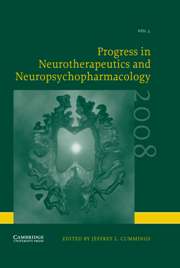Article contents
The NIMH MATRICS Initiative: Development of a Consensus Cognitive Battery
Published online by Cambridge University Press: 05 October 2006
Extract
ABSTRACT
A key obstacle to the development of new drugs to treat the cognitive deficits of schizophrenia was the absence of a standard by which to measure their efficacy. Before granting approval for any new drug for this condition, the US Food and Drug Administration wanted a standard cognitive endpoint based on a broad consensus-based method. To address this obstacle, the Measurement and Treatment Research to Improve Cognition in Schizophrenia (MATRICS) intiative oversaw a process to develop a consensus neurocognitive battery. Its development included a ten-step process that is described in this article.
- Type
- Review Article
- Information
- Progress in Neurotherapeutics and Neuropsychopharmacology , Volume 2 , Issue 1 , March 2007 , pp. 173 - 186
- Copyright
- © 2007 Cambridge University Press
References
- 1
- Cited by




